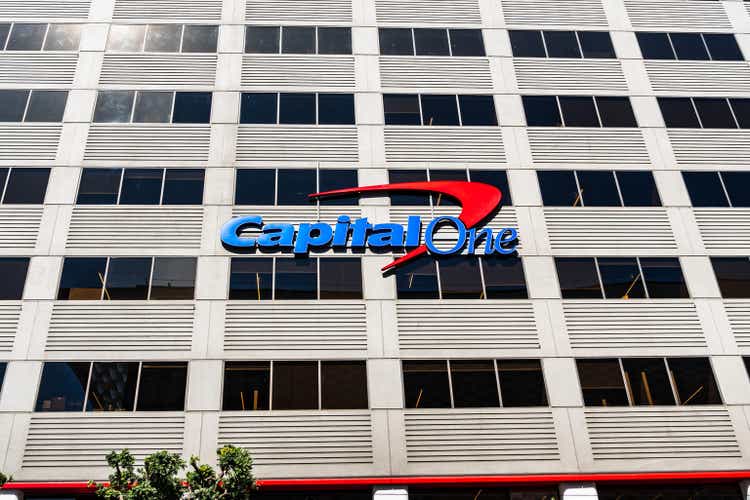Even With Higher Rate And Inflation, Capital One Looks Good
Summary:
- Capital One saw a great year in 2021 due to the lowering of the allowance ratio, strong & healthy customers, and rising interest rates.
- In Q1 2022, the rising rates and high inflation did not show in the credit metrics, but the bank stopped reducing reserves.
- While the current economic environment will certainly affect Capital One customers, at 1.35x tangible book value, the bank is still fairly valued.
Sundry Photography/iStock Editorial via Getty Images
Introduction
Over the past three years, Capital One (COF) has seen various business environments to work with. The pandemic saw the bank push reserves sky-high, but also an exceptionally healthy consumer. As the pandemic was contained, the bank continued to see a strong consumer and could reduce the reserves, thus boosting profits to unforeseen levels. Now the environment seems to be shifting again, with a rising rate economy and high inflation. While this hasn’t reared its ugly head in Q1, there will certainly be pressure on the bank this year. This is something to watch, but at 1.35x tangible book value, I think the bank is still fairly valued, and I am adding more to my position.
Fiscal Year 2021
Capital One had a stellar year in 2021. This was due to a few factors working in conjunction to boost the bottom line by 357%. But first, looking at the top line, Capital One posted total revenue growth of 7% on the back of net interest income and non-interest income growth of 5% and 12% each. This coincides with a slight increase in assets held and increasing interest rates. Net interest margin grew 15 basis points, and total assets grew by 3%.
What pushed the bank into such high net income growth though was the negative provision for losses booked on the year. Capital One removed $1.944 billion from the reserves in 2021 as the bank saw potential pandemic issues dissipate. With this action, the bank lowered the allowance ratio to 4.12%, a decrease of 207 basis points from 2020. The result was a huge boom in net income, which came in at $12.390 billion, or $26.94 a share.
Looking at the credit metrics shows how everything went right for Capital One this year. Paired with the lowering allowance ratio and higher net interest margins, customers were extremely healthy this year. The net charge-off rate and delinquency rate were astonishingly low. The net charge-off rate for 2021 was just 0.88%, down 118 basis points from last year’s already low rate. The 30+ day delinquency rate was 2.41%, for a decline of 20 basis points. What this shows is that Capital One customers have easily been able to pay back what is owed to the bank. Capital One also held costs in check with an efficiency ratio of 54.44%, increasing only 1.65%. Overall, everything that could go right for the bank did in 2021, and the results were an incredible bottom line.
Q1 2022
Looking at the first quarter of 2022 shows a continuation of some of these trends. Total revenue has increased by 15% year-over-year, with net interest income and non-interest income up 10% and 38% respectively. So far this year, the bank posted a provision for losses of $0.677 billion, a stark contrast to the -$0.823 billion last year. It seems that Capital One is going to try and keep the allowance ratio around the 4% mark instead of the pre-pandemic 2-3%. This is most likely due to the economic factors arising such as rising interest rates and inflation that will reduce customer strength. While this is a very important factor to watch in upcoming quarters, the credit metrics haven’t changed much yet. The net charge-off rate was a bit higher than the 2021 total at 1.11% but was still down 10 basis points year-over-year The 30+ day delinquency rate was lower than the 2021 total at 2.11% and declined 20 basis points year to year. The bank ended the quarter with a net income down 28% and an EPS of $5.62 due to the provision for losses, but overall this was a good quarter for Capital One.
Valuation
As of writing, Capital One trades at a price level of around $125. At this price point, the bank trades at a P/E of just 4.64x 2021’s EPS. But because of the nature of the 2021 results, the P/E isn’t a good way to value the bank. Looking at book value provides a much clearer value of the institution. As of the most recent quarter, Capital One trades at a P/BV of 0.89x and a price to tangible book value of 1.35x. The company also offers a 1.91% dividend yield. I believe the bank is fairly valued right now. Because of this, I am looking to add more to my position as the price drops below $120 per share.
Conclusion
Capital One saw an incredible year in 2021 with all the stars lining up. The bank saw a reduction in the allowance ratio, high-interest rates, and a strong customer base that allowed for a 357% jump in earnings. Much of the same trends held in the first quarter of 2022, but it seems the bank is now holding steady with the current allowance ratio. Therefore, I would not expect more boosts from negative provisions for losses in 2022, especially as inflation and rising rates negatively affect customers. And while these two factors will certainly put pressure on Capital One customers, I believe the bank is fairly valued at the current price.
Disclosure: I/we have a beneficial long position in the shares of COF either through stock ownership, options, or other derivatives. I wrote this article myself, and it expresses my own opinions. I am not receiving compensation for it (other than from Seeking Alpha). I have no business relationship with any company whose stock is mentioned in this article.

